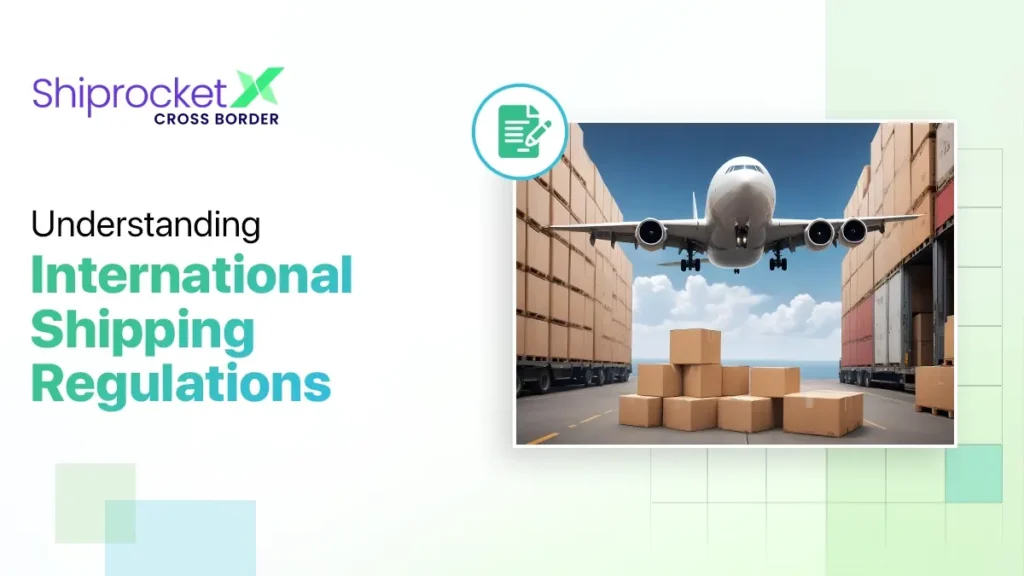International Shipping Regulations: Mastering the Basics
- International Shipping Fundamentals
- Essential Documents for International Shipping
- Understanding Some Common Terms Used in International Shipping
- International Shipping Agreements: Types and Implications
- Crucial Elements of International Shipping Regulations
- 1. Customs Documentation
- 2. Harmonized System (HS) Codes
- 3. Import and Export Regulations
- 4. Sanitary and Phytosanitary (SPS) Measures
- 5. Packaging and Labelling Standards
- 6. Environmental Regulations
- 7. Security Measures
- 8. International Maritime Dangerous Goods (IMDG) Code
- 9. International Traffic in Arms Regulations (ITAR)
- 10. Harmonized Tariff Schedules (HTS) and the Importance of Country of Origin Certificates
- 11. Selecting the Proper Incoterms
- 12. Commerce Control List
- ShiprocketX: Revolutionising International Shipping Solutions
- Conclusion
Navigating international shipping regulations can be challenging, but companies involved in international shipping need to be completely knowledgeable about them. These laws safeguard national interests, uphold safety standards, and promote fair trade practices. To cut short, following these shipping standards prevents your shipment from being held or ceased.
Therefore, understanding international shipping standards is essential to succeeding in the increasingly globalised world of eCommerce.
If you are looking to ship your products to some other country and import them from another territory, you are on the right page. This article provides insights into international shipping regulations. Make sure you comply with these regulations, as they ensure the timely delivery of goods, leading to customer satisfaction.

International Shipping Fundamentals
The primary thing to understand about international shipping is that every country has its own set of rules and regulations for shipping. These guidelines state what goods are allowed and what are not, plus the taxes, fees, penalties, etc. It is essential to know about international shipping regulations so that the shipment can be delivered on time without any delays.
Below is the list of major parties involved in international shipping:
- Carriers: Carriers are the companies that own planes, they offer transportation services from one point to another. You can book them mostly through third parties.
- Forwarders: They are the travel experts who know the end-to-end shipment process. They are the ones who make shipment easy as they take care of all the rules and regulations of the different countries, customs, taxes, etc. They ensure that the goods are delivered in a timely manner without any hindrance.
- Custom Brokers: They are specialists in customs filing and clearing. Many freight forwarders partner with them to handle customs clearance.
- Third-Party Logistics Provider: They provide logistics services and support various or almost all aspects of a business’s shipping operations, starting from moving goods from manufacturers and distributors to the end customer.
- Shippers: The shipper is the person who wants the goods transported. The logistics chain starts with them, as the demand for the other parties arrives only when there is a shipment requirement.
Essential Documents for International Shipping
Here is the list of some of the mandatory documents required as per the international shipping standards:
- Commercial Invoice: This document comprises the details of the transaction between importer and exporter, such as goods to be shipped, their value and terms of sale
- Material Data Safety Sheet: This document is required for hazardous goods and is required when the Shipper’s Letter of Instruction is prepared.
- Bill of Lading: It is a contract of carriage between the shipper and carrier. This contract comprises information on cargo items, shipping routes, and delivery instructions.
- Fumigation Certificate: This document is needed when wood or any other natural products are being shipped. Your supplier can arrange for this letter. Custom clearance is required and will be needed when the Shipper’s Letter of Instruction is prepared.
- Certificate of Origin: It is yet another essential document, it specifies the origin of the goods or can also be said to be the proof of sale and is important for applying tariffs and trade agreements.
- Packing List: It is like a packing slip that is provided for domestic shipping, but it is in more detail as it includes the cargo items with their value, cargo destination, packing details, extra instructions and the quantity, dimensions and weight of every item.
- Shipper’s Letter of Instruction: This one document is your order form. It tells important information to your freight forwarders, such as the name and address of the shipper and consignee, cargo’s destination and description of the goods so that they transport the goods correctly.
- Power of Attorney: This document states that your forwarder can deal with customs in your place.
- Booking Confirmation: This is the main receipt provided by the carrier to your forwarder and later given to you. In various cases, the booking confirmation number is the shipping tracking number.
Understanding Some Common Terms Used in International Shipping
When you are into international shipping, it is vital to have a good understanding of the common terms that are used in the industry. Here are the most significant ones-
- Arrival Notice: This is the notification or message sent by the carrier when the shipment arrives to the consignee or notified party.
- Balloon Freight: This is the freight that is low in weight but is high in volume.
- Bulk Cargo: These are the shipments that are shipped loose, they are not packed in containers or packages, such as grains, coal, etc.
- Cabotage: The transfer of goods between two places in the same country but by a transporter from another country.
- Concealed Loss: This means a shortage or damage to the goods that is not evident at the time of delivery.
- Direct Exporting: The sale of goods directly by an exporter to an importer in another country.
- Drawback: This refers to the partial refund of an import fee. It is usually given when the goods are re-exported from the country that collected that fee.
International Shipping Agreements: Types and Implications
As per international shipping regulations, there are various essential agreements required for the product you are shipping and for the country in which the product is being sent. Here are some of the essential international shipping agreements that one should be aware of:
1. Cost, Insurance, and Freight (CIF)
The CIF is determined based on the Value Added Tax applied to the goods’ sum and the cost of shipping.
2. Carriage and Insurance Paid to (CIP)
CIP means that the seller delivers the goods to an approved person at an agreed location. This agreement states that the seller is responsible for paying for the freight and insurance charges but the risk of any damage or loss of the goods transfers from the seller to the buyer as soon as the carrier receives the goods.
3. Free on Board (FOB)
FOB is calculated based on the VAT (Value-Added Tax) when applied to the price of the goods without adding any shipping charges.
4. Delivered at Terminal (DAT)
DAT means that the seller will deliver the goods when they are unloaded at the destination terminal. The delivery is not complete until the goods reach the destination agreed upon by both parties.
5. Delivery Duty Paid (DDP)
DDP means that the seller is responsible for all the costs and risks involved in the delivery of goods; therefore, the seller has the maximum obligation in this. The seller will have to deliver the cargo to the buyer, clear all the taxes and duties, and be ready for unloading at the agreed-upon destination.
Crucial Elements of International Shipping Regulations
Below are the important elements of International shipping regulations you need to know-
1. Customs Documentation
It is an official document that lists and provides information about the goods that are being shipped. It is a fundamental requirement for international shipping.
Customs clearance should be as efficient as possible to ensure legal and ethical transactions. It’s vital to complete all the required documentation correctly, as failure to do so can have a negative impact on both you and the customs clearance process.
2. Harmonized System (HS) Codes
It is a standardised numerical method of classifying traded products. These classification codes are used worldwide. Over 200 countries and economies use these codes to identify goods when determining their customs tariffs or other fees and penalties.
Assigning the right HS code is important as it makes it easy for the customs department to apply the right import duties and taxes.
These codes make it easy to make a distinction between goods categories. The HS codes are usually reviewed every five years to include the new technologies, patterns and trends, and new goods that enter the global market and are traded in huge volumes.
3. Import and Export Regulations
Export and Import regulations majorly control which products and technologies can be transported freely. Each country has its own import and export regulations, which can vary significantly. Therefore, before shipping the products, it is essential to check their regulations so that your shipment is delivered without any delay.
Export controls are usually country-based and are majorly implemented in a way that aligns with national security and foreign policy. On the contrary, import controls are basically centred on the safety of citizens or a national economy, for example, restrictions on importing harmful chemicals or toys with parts that can cause a choking hazard to kids.
4. Sanitary and Phytosanitary (SPS) Measures
SPS measures are created to protect human, animal, or plant life from risks that arise due to the spread of pests and diseases or additives, toxins, and contaminants in food. If your goods are unable to meet the SPS measure, your shipment will be rejected and will not be processed further.
SPS measures must be made keep in mind scientific principles and not maintained without scientific evidence. The SPS Agreement comprises provisions to ensure transparency in the creation and implementation of SPS measures, including the publication of SPS measures that apply to imported commodities.
5. Packaging and Labelling Standards
Proper packaging safeguards the items from potential damage that might take place during handling, loading, and unloading. Different countries have their own packaging and labelling standards for products. These standards may demand language requirements, safety labelling, and packaging materials. If their standards or regulations are not followed, it can lead to delays and fines.
In general, as per international shipping standards, shipping labels should include details like the origin and destination addresses, the shippers’ and recipients’ names, contact information, purchase order numbers, etc. If you are shipping hazardous materials, the label should inform handlers about the nature of any associated risks and proper handling procedures to ensure safety.
6. Environmental Regulations
International environment policy covers numerous things, such as climate protection, sustainable waste management, energy policy, protection against hazardous substances, and much more. Therefore, as per international shipping regulations, hazardous materials, harmful chemicals, etc., are not allowed to be sent.
It is important to follow environmental regulations when shipping your goods as it might lead to delays in shipments. Furthermore, by following these rules, you can continue to support global trade while also protecting the planet for future generations.
7. Security Measures
There is a set of security measures that one needs to follow so that no illegal or harmful products are shipped. Particularly after the 9/11 attack in the US, security checks when shipping products have become a significant concern. These security measures are taken to avert acts of terrorism that can possibly hamper global trade and cause significant economic repercussions.
The International Ship and Port Facility Security (ISPS) Code establishes an international framework for detecting security threats and taking appropriate measures against security incidents that might affect international trade.
8. International Maritime Dangerous Goods (IMDG) Code
The IMDG code is an internationally created regulation that groups dangerous goods based on the hazards they present in transportation. Dangerous goods are substances or items that pose a risk to safety, health, the environment, or property while shipping. This code was created to enhance and harmonise the safe transit of dangerous goods and to prevent pollution of the environment.
If you are shipping dangerous goods, the IMDG code requires a declaration from the consignor mentioning that the particular dangerous goods are identified, classified, packaged, marked, labelled, and placarded correctly. This code is important to enhance the safe transit of dangerous goods while facilitating free, unrestricted movement.
9. International Traffic in Arms Regulations (ITAR)
The ITAR is a set of US government rules that administer the shipping of defence goods. It is approved by Section 38 of the Arms Export Control Act, which permits the President to control the exchange of defence articles and services. It applies to all the defence products that are on the United States Munitions List (USML).
This list is categorised into three sections, defence articles, defence services, and related technical data. To comply with ITAR, it is essential that the company must register itself with the DDTC and apply for an export licence or temporary import licence.
10. Harmonized Tariff Schedules (HTS) and the Importance of Country of Origin Certificates
HTS code is an international harmonised system of numbers and names used to categorise traded products. The major benefits of using HTS codes are that they support global trade by making the customs processes easy, helping countries impose tariffs accurately, enforcing trade regulations, and collecting trade statistics.
An HTS code consists of ten digits, each with every set representing a particular product category or sub-category. These codes are broken into five different sections, the first two characters identify the chapter in the HTS, the next two digits the heading within that chapter, the other two digits identify the subheading within that chapter, the subsequent digits establish duty rates, and the last two digits are statistical suffixes that collect trade data.
11. Selecting the Proper Incoterms
The word “Incoterm” is an abbreviation for International Commercial Terms. Incoterms outline the parties’ responsibilities under a contract for international sales of goods. It is important to choose the right Incoterms. You must consider the following factors when selecting an Incoterm for a sales contract, such as:
- Mode of transportation
- Types of goods
- Level of experience of the parties
- Relationship between the seller and buyer
- Control over the goods, operations, and cost
- Whether an Incoterm is more suitable for importation or exportation
- Insurance policies.
Following correct international shipping terms is important for the international shipment of goods as it gives certainty to the contract.
12. Commerce Control List
The Commercial Control List states the limitations and regulations on the products that are being exported to the US. These categories and product groups ultimately create an alphanumeric code (i.e. 4E001) called an Export Control Classification Number (ECCN). The Commerce Control List consists of ten categories and five product groups, as shown below:
- Commercial Control List Categories:
- Nuclear materials, facilities and equipment
- Materials Processing
- Computers
- Electronics
- Materials, Chemicals, toxins and Microorganisms
- Sensors and Lasers
- Marine
- Telecommunications and Information security
- Navigation and Avionics
- Propulsion Systems, Space Vehicles and Related Equipment
- Five Product Groups:
- Systems, Equipment and Components
- Material
- Software
- Technology
- Test, Inspection and Product Equipment.
ShiprocketX: Revolutionising International Shipping Solutions
Are you looking for a trusted partner for international shipping services? Look no further than ShiprocketX. The company offers end-to-end shipping solutions without any heavy documentation.
They offer cutting-edge shipping solutions designed to revolutionise and enable adaptable and economically viable shipping. The carrier provides efficient cross-border eCommerce shipping and time-sensitive deliveries.
With ShiprocketX, you can go from local to global with ease. These are the primary features of this logistics provider:
- Lightening-Fast Deliveries: With ShiprocketX, fast and efficient deliveries are what you can expect.
- Seamless Customs Clearance: Exporting your shipments is no longer a hassle and time-consuming process. With this platform, you get transparent billing and tax compliance that ensures your goods reach the market without any extensive documentation and paperwork.
- Multiple Shipping Modes: You get numerous shipping options. You get numerous shipping options. Choose the one that fits your business needs with end-to-end visibility. The six shipping modes you can choose from include:
- ShiprocketX Economy
- ShiprocketX Premium
- ShiprocketX Premium Plus
- ShiprocketX Premium Books
- ShiprocketX Priority
- ShiprocketX Express
- Real-Time Updates: ShiprocketX uses technology such as a global positioning system (GPS) and IoT (Internet of Things) to help eCommerce businesses like yours keep their customers informed about the current location of their products through WhatsApp and email.
- Analytics Dashboard: This platform enables sellers to make data-driven decisions by enabling them to view shipping metrics, courier performance, country-wise distribution, bestsellers, and buyer persona.
- Easily Manage Returns: ShipcoketX enables easy and hassle-free returns.
- Dedicated Account Manager: You get a proficient cross-border expert to assist you with all your queries and concerns.
Conclusion
Understanding the global shipping rules might be difficult, but it is essential for successful cross-border trade. Following these international shipping regulations when shipping your product overseas lets you expand your footprint worldwide. Moreover, choosing a reliable and expert carrier like ShiprocketX makes it even easier to handle your shipment from pickup to delivery.
Leverage the power of ShiprocketX, having 11+ years of experience in the logistics industry. They simplify your exports while staying within the boundaries of your budget.





